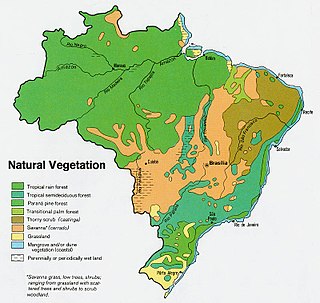Gonatogyne is a genus of plants in the family Phyllanthaceae first described as a genus in 1873. It contains only one known species, Gonatogyne brasiliensis, endemic to southeastern Brazil.
Asteranthos is a genus of woody plant in the family Lecythidaceae. There is only one known species, Asteranthos brasiliensis, native to Venezuela and Brazil.

Hypolytrum is a genus of plant in the family Cyperaceae. It contains approximately 60-70 species, native to tropical Africa, Asia, Australia, Latin America and various oceanic islands.

Schoeneoplectus californicus is a species of sedge known by the common names California bulrush, southern bulrush and giant bulrush. It is also sometimes called "tule", but the closely related Schoenoplectus acutus is the species most often referred to by that name.

Aechmea calyculata is a plant species in the genus Aechmea.

Bixa is a genus of plants in the family Bixaceae. It is native to Mexico, Central America, Caribbean, and South America, and naturalized in other places.
Aechmea bicolor is a species in the genus Aechmea. This species is endemic to the State of Santa Catarina in southern Brazil.

Aechmea marauensis is a species in the genus Aechmea. This species is endemic to the State of Bahia in eastern Brazil.
Guzmania melinonis is a species of plant in the genus Guzmania. This species is native to Bolivia, Peru, Colombia, the Guianas, Venezuela, Amazonas State of Brazil, and Ecuador.
Rauhiella is a genus of flowering plants from the orchid family, Orchidaceae. It contains three known species, all endemic to Brazil.
Picrasma crenata, the pau-amargo, pau-tenente or tenente-josé, is a tree species that belongs to the family Simaroubaceae. It occurs in Brazil, in the regions Nordeste, Sudeste and Sul.
Maytenus aquifolia, the espinheira-santa, is an endemic tree species endemic to the Atlantic Forest biome in southeastern Brazil,

Syagrus cearensis is a natural palm endemic to Brazil.
Monochilus is a genus of plants in the mint family, Lamiaceae, first described in 1835. It contains two known species, both endemic to Brazil.
- Monochilus gloxinifoliusFisch. & C.A.Mey. - Rio de Janeiro
- Monochilus obovatusP.D.Cantino - Goiás
Kerbera is a species of plants in the Apocynaceae first described as a genus in 1885. It contains only one known species, Kerbera eichleri, endemic to the State of Rio de Janeiro in Brazil.
Petalostelma is a genus of flowering plants formerly belonging to the plant family Asclepiadaceae, now considered to be part of the Apocynaceae, first described as a genus in 1885. They are native to South America.
Nautonia is a species of plants in the family Apocynaceae first described as a genus in 1844. It contains only one known species, Nautonia nummularia, native to Brazil.

Araras State Biological Reserve is a biological reserve in Rio de Janeiro, Brazil.

Lista de espécies da flora do Brasil, first produced in 2010 provides a list of species of plants found in Brazil. At that time it listed a total of 40,982 species, including 3,608 fungi, 3,495 algae, 1,521 bryophytes, 1,176 pteridophytes, 26 gymnosperms and 31,156 angiosperm species. The list is constantly updated with more than 400 taxonomists working on the online database.







